Teacher's Toolkit
Exploring Acceleration
A Dive Into Newton’s Second Law of Motion
Science Scope—September/October 2020 (Volume 44, Issue 1)
By Kelly Rose Kosa and Rommel J. Miranda
CONTENT AREA Physical Science
GRADE LEVEL 6–8
BIG IDEA/UNIT Forces and interactions
ESSENTIAL PRE-EXISTING KNOWLEDGE Students should have explored balanced and unbalanced forces in a system (Newton’s first law).
TIME REQUIRED Three 90-minute classes or 270 minutes
COST Less than $30 for a class of 30
SAFETY Keep pathways clear, report all accidents, wear safety goggles when testing vehicles, follow all instructions given by the teacher, and leave workstation clean and in good order before leaving the laboratory.
Newton’s second law of motion (a = F/m) is essential to understanding forces and interactions, and it can help students to predict the behavior of objects. However, in our experience teaching Newton’s second law, we have noticed that students often have conceptual difficulty understanding that an object accelerates in a way that is affected by its net force and mass. Many students initially believe that the heavier the object is, the farther and faster it will travel, regardless of whether motion is vertical or horizontal. They have formed this misconception because they have seen common everyday examples such as when two people go down a slide, the heavier person always reaches the bottom first. However, students often do not consider gravity to be the essential force in that situation (The Physics Classroom 2018). On the basis of our teaching of this topic and recognizing students’ common misconceptions, we believe that it is essential for educators to develop and refine students’ understanding of Newton’s second law of motion using an inquiry-based approach, so they can develop a coherent understanding of forces and interactions.
In this article, we present a lesson to help deepen students’ conceptual and functional understanding of Newton’s second law of motion. Our lesson for developing, enlarging, and refining students’ initial ideas about Newton’s second law of motion uses a 5E (Engage, Explore, Explain, Elaborate, Evaluate) learning cycle model (Bybee 1997) to help illustrate how science teachers can immerse students in a range of inquiry-based science experiences. We also use the Know-Learn-Evidence-Wonder (KLEW) instructional teaching strategy (Hershberger, Zembal-Saul, and Starr 2006).
Engage
The teacher engages students in the topic by presenting a Hot Wheels commercial, the Double Dare Snare (see Resources). This video introduces the correlation between force, mass, and distance; the device easily launches the lightweight Hot Wheels cars due to the small amount of force needed. After watching, the teacher instructs students to discuss with a partner and together compile some ideas on their activity worksheet (see Online Supplemental Materials) about what makes the Hot Wheel cars travel such a great distance (all activities are recorded on the activity worksheet). After a few minutes, the teacher facilitates a whole-class discussion with students by asking them what they believe has the most effect on the car. Students mentioned size of the car and strength of the launcher. To elicit students’ initial ideas and their current understanding of forces, the teacher issues a formative assessment by asking students to observe a series of paired photographs and construct a list of at least three factors that would affect the object’s speed (or distance/time). The slideshow includes a series of vehicles that are large and small, light and heavy, and fast and slow. The teacher may utilize the PowerPoint provided (see Online Supplemental Materials).
The teacher instructs students to work independently and, after they have written their list, to work collaboratively in pairs to produce new ideas. The primary goal is to help students recognize the relationship between mass, force, and acceleration; the more mass an object has, the more force needed to move or accelerate the object. If students are not formulating a connection, the teacher poses the question, “When something moves faster, is there a word we could use to describe speeding up?” (answer: acceleration). The teacher then conducts a whole-class discussion with students regarding their responses. As groups share their responses, the teacher records their ideas under the “Know” section of the KLEW chart shared on a Google document. Several groups mentioned size, weight, aerodynamics, and the strength of the force.
Explore
The teacher tells students they will work in a group of three to build and design a vehicle made for long distance racing and provides the guiding question, “Can you construct two different vehicles that will travel farther than your peers’ vehicles?” Creating two different vehicles (see Figure 1) will likely create differences in mass, which will lead to recognizing the relationship between mass, force, and acceleration. The teacher instructs students to consider the factors that were elicited from the photographs, such as size, weight, and force, and then informs the class that there is a designated race track (middle of the room) where each vehicle will be affected by a force. The teacher reminds students that for force to be consistent, every vehicle needs to experience the same amount of force, to be provided by a hair dryer. The force will be constant for each trial, with the dryer moving the vehicle over a 2-feet or 60-cm distance.
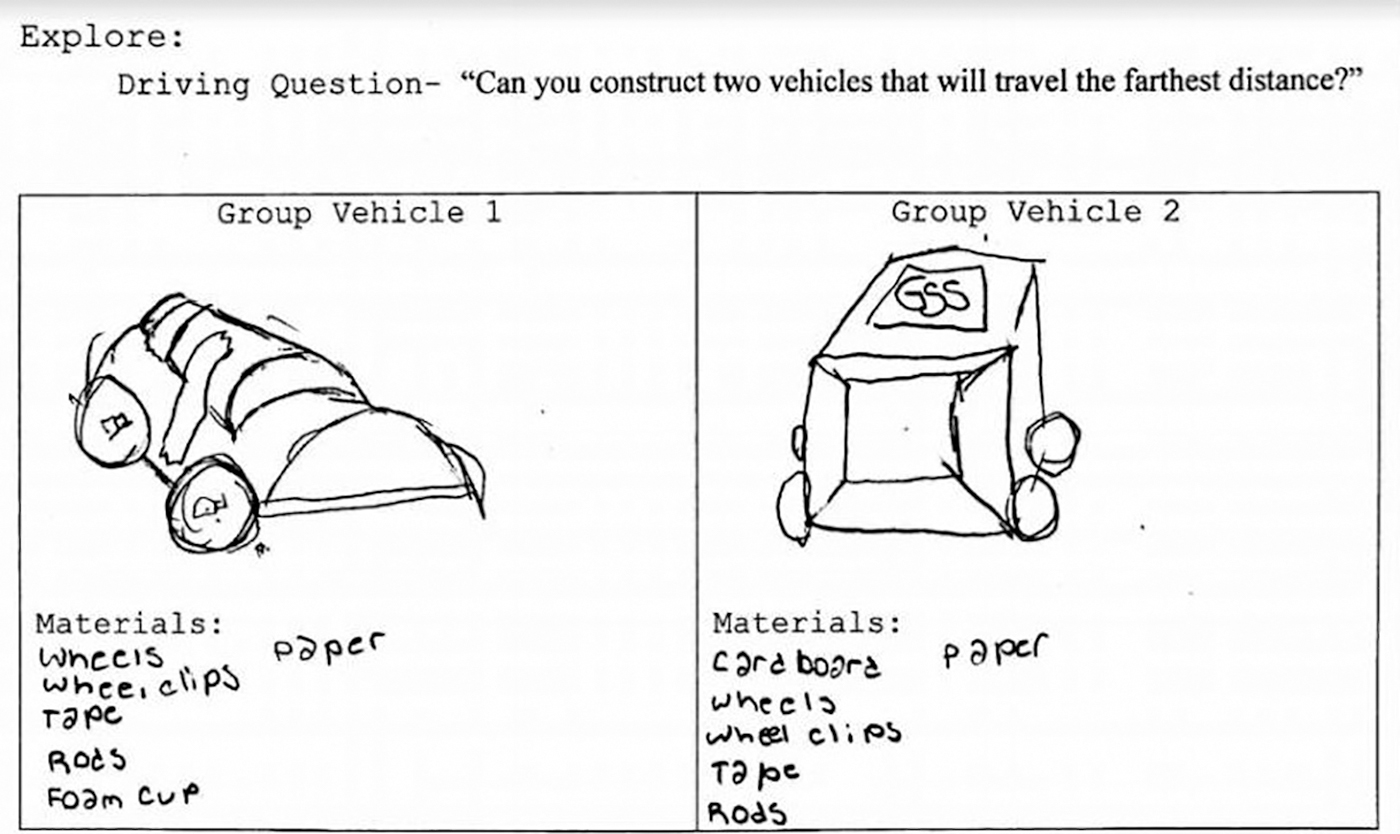
Students’ design of two vehicles and the materials needed
In their groups, students have no particular role because the teacher encourages them to work together. If you wish to assign roles, some roles for this investigation may be a prediction manager who generates hypotheses and claims; an evidence collector who analyzes the results; a researcher who explores other ideas and findings about the topic; and last, a skeptic who encourages the group to consider alternative perspectives (Voreis, Crawley, Tucker, Blanton, and Adams 2008). Students are provided with unlimited weighted washers (1.9 cm), index cards (7.62 cm × 12.7 cm), cardboard, foam cups, paper/plastic cups, and paper clips. They are also provided with 100-cm maximum of masking or Scotch tape and four 2.54-cm radius K’NEX wheels and connectors. The teacher instructs one student in each group to obtain materials from the supply table and bring them back to their table. The teacher also instructs students to design their vehicles and formulate a list of features/materials they think will help in reaching the farthest distance. They may follow the rubric provided by the teacher (see Online Supplemental Materials).
Students have roughly 30 minutes to build both of their vehicles. The vehicle can only be a maximum of 20 cm by 20 cm (approximately 8 in. by 8 in.) in length and width. The teacher roams to approve the student procedures as they are working. When building, some students may assemble vehicles that have a difficult time traveling due to factors such as improper wheel attachment. Teachers may want to monitor the assembly process so this challenge can be limited; for example, by reminding them that the wheels must be able to rotate properly for it to travel without assistance. To help deter students from creating similar vehicles, the teacher should reinforce different as the key word so students can see variance between them. During this process, the teacher should also clearly explain the specific safety and clean-up procedures—keep pathways clear, report all accidents, follow all instructions given by the teacher, and leave the workstation clean and in good order before leaving the laboratory. See examples of students’ constructed vehicles in Figure 2.
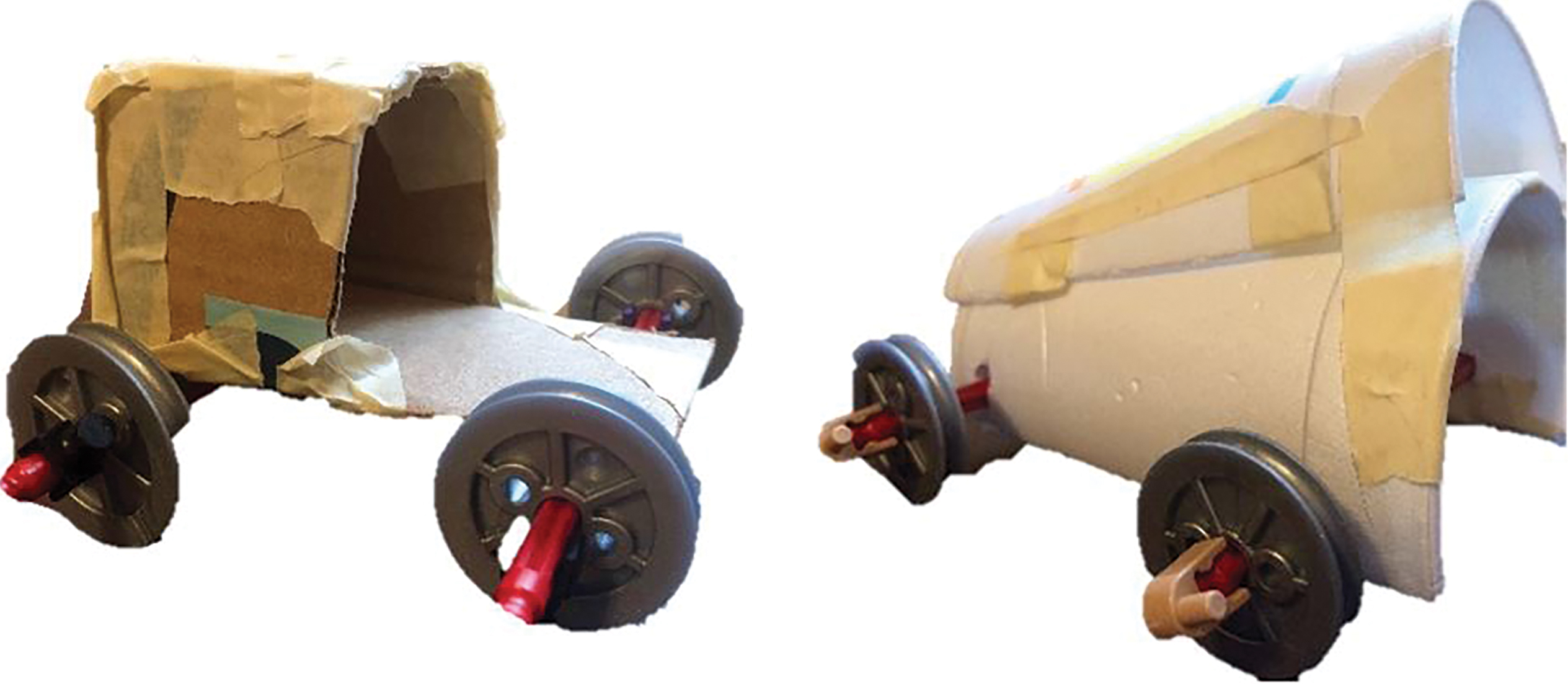
Examples of student constructed vehicles for testing
Testing the vehicles
To test, the vehicle begins on a starting line. The teacher uses the hair dryer to blow the vehicle from directly behind for 2 feet and then removes the force (see Figure 3). Students measure the distance traveled from the 2-foot or 60-cm line to where it landed. Each car is tested once, if the procedure is executed properly; the limit is placed due to time restrictions. As an alternative to a hair dryer, teachers can also use a rubber band to keep a constant force on cars of different mass. The rubber band can be extended between two legs of a chair and pulled back to launch the vehicle forward. The vehicles can be tested in the hall or on the floor of the classroom if space is available, while all participants wear safety goggles during testing.
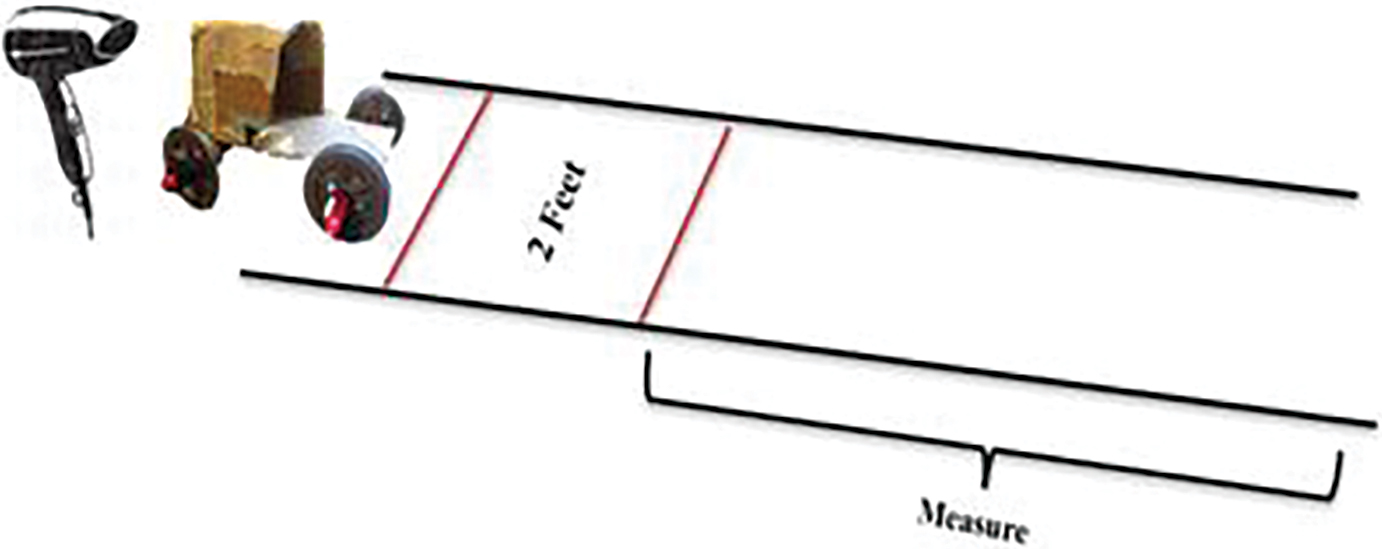
The set-up for testing the vehicles
The teacher creates a table on the front board and students record the distances their vehicles traveled, as well as their peers’ vehicles, in the labeled dependent variable column (see Figure 4). The independent variable has yet to be discovered and therefore has not been labeled. The teacher instructs students to discuss with their teams what they believe was the most influential factor in traveling the farthest distance. The teacher scaffolds the discussion by having balances readily available for students to ensure that students will propose the factor of mass. Once mass is suggested, students mass their cars to see if their predictions are correct. They establish that mass is the independent variable because the distance of the vehicle depends on the mass, and they continue to complete the class table. Students record five other groups’ distances and masses in their personal table and graph the select ordered pairs (see Figure 5). For each of the five vehicles, a data point is recorded on the graph. The x-axis represents the independent variable, mass, and the y-axis represents the dependent variable, distance. This final step establishes a visual connection between mass and acceleration to show that the more mass the vehicle has, the less acceleration or less distance covered.
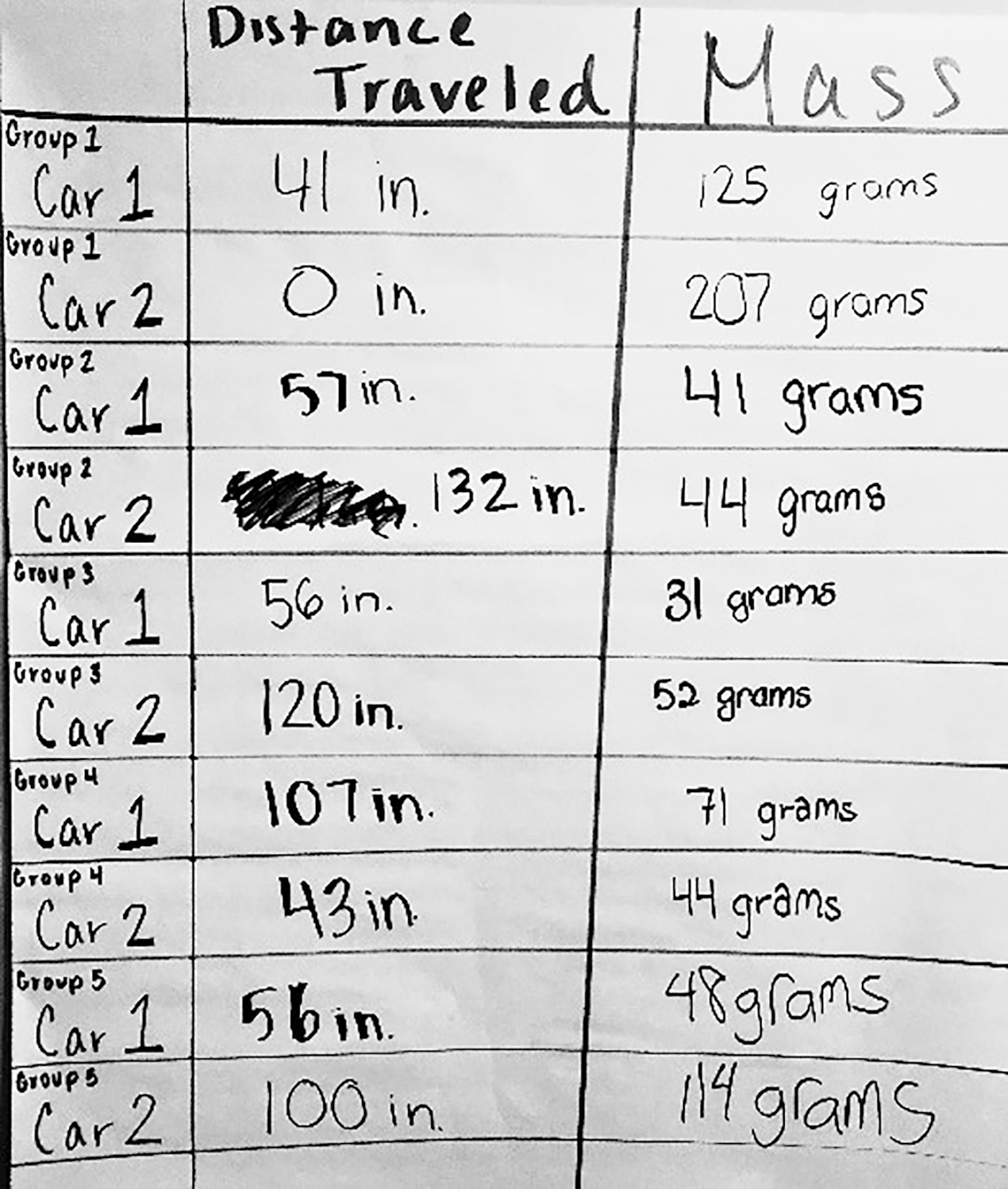
Students record their distances in the labeled dependent column, then generate the independent column once mass is suggested
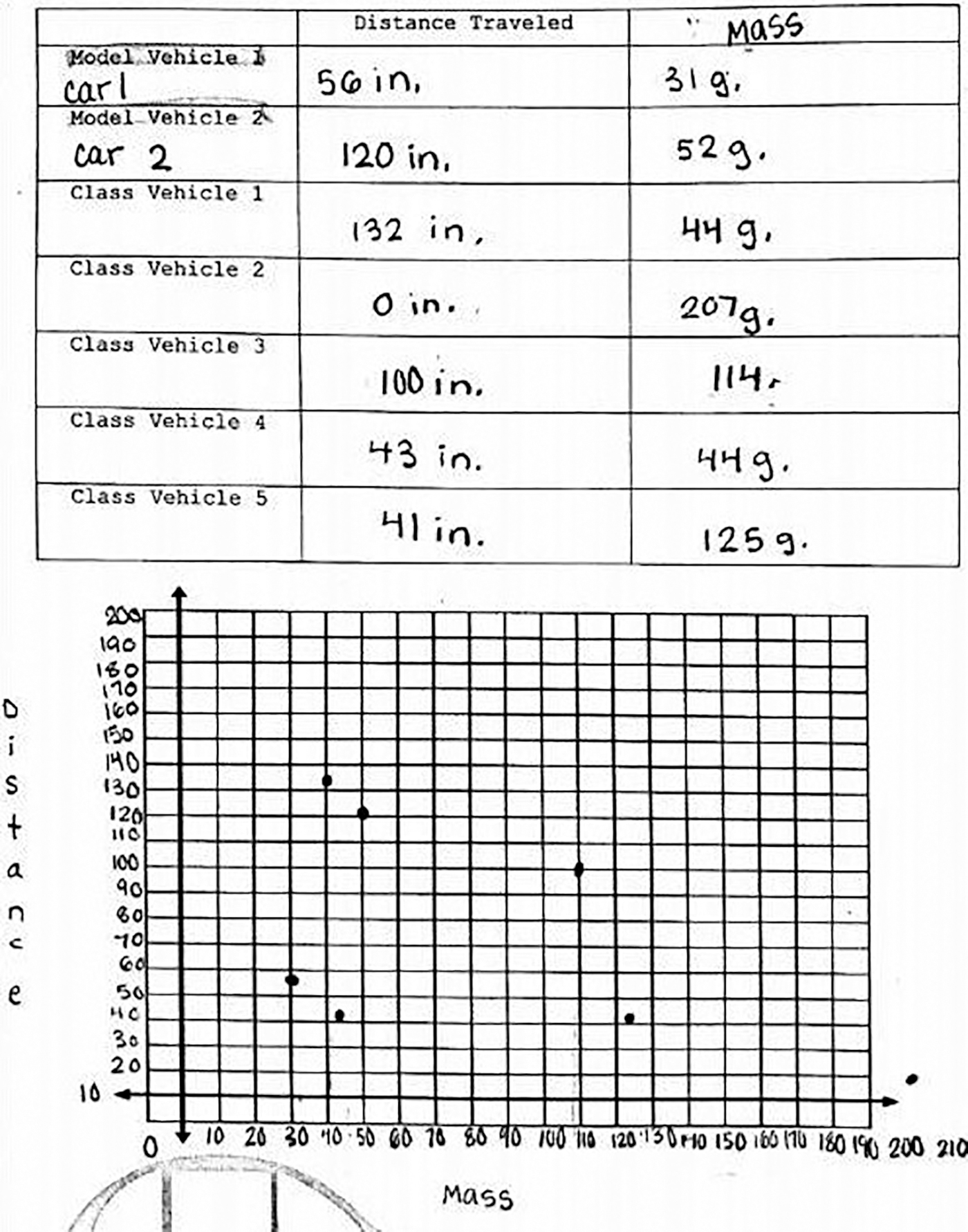
Students’ data graphed on a scatterplot, downward slope
Differentiation strategies
To differentiate this activity for students with special needs, the teacher varies the pace of instruction (reinforced vocabulary when appropriate, reviews extracted content, etc.), appeals to students’ personal interests (real-world examples), modifies classroom activities based on ability, and rewards students based on individual progress. For some classes, assigning roles may be beneficial to cut down on unrelated discussions and promote different types of thinking in the group. For English language learners, the teacher may provide definitions for key vocabulary, utilize sentence starters, and offer audio and visual supports.
Explain
The teacher prompts student groups to articulate what they have learned about force and motions based on observations and evidence collected using their vehicle models and the previous discussions by answering the students’ responses under “Learn” and “Evidence” on the shared KLEW document. Some student groups mentioned that their first vehicle weighed a lot less than their other and went a significant amount further in distance.
After the groups present their findings to the class, the teacher reviews vocabulary terms such as distance, speed, and velocity, and introduces new terms such as acceleration, force, and Newton’s second law (force = mass × acceleration) to explain what students are describing related to forces and interactions. The teacher may utilize the PowerPoint provided (see Online Supplemental Materials). They then propose the question, “What happens to the acceleration of an object with a constant mass if the applied force is varied (if the force is increased or decreased)?” This question extends students’ understanding of the law because they designed cars that varied in mass and noticed how that affected its acceleration; however, students need to realize what would happen if another variable were altered.
The teacher then asks students to design and draw a new vehicle that they believe would travel the farthest distance, when a constant force is applied. Using their new design, students answer the following question in writing: “Why will this vehicle be more successful than the original vehicles in traveling the furthest distance?” After five minutes, the teacher conducts a discussion during which each student articulates their understanding of Newton’s second law of motion and why their vehicle will be successful in traveling the furthest distance. Students should begin to make the connection that the revised vehicles should have less mass.
Elaborate
The teacher revisits the opening question, “What makes the Hot Wheel cars travel such a great distance?” and instructs students to answer the question with an explanation. After a few minutes, the teacher facilitates a whole-class discussion with students regarding their explanations by asking the following questions:
- How would the velocity of the object and distance change if force had increased or decreased in strength? (Students may answer, “The cars would travel faster and farther if the force had increased.”)
- What does mass have to do with force? (Students may answer, “The more mass an object has, the more force is needed to have an effect on it.”)
If students produce common misconceptions during the discussion, such as the heavier the object is, the farther and faster it will travel, the teacher will refer to the exploration and explanation sections to formulate connections between the activity and the findings.
Next, the teacher asks students to provide another example of Newton’s second law that is demonstrated in everyday life. Students work in their groups to discuss predictions of examples they have seen and record their predictions. Some examples students may list are pushing a shopping cart or a horse pulling a carriage. They instruct students to choose one of their examples and conduct research using a computer. They should address the following points: What is the force acting upon the object? How do you know there is a force present? What factors affect the acceleration of the object? What factors are limiting or could limit the object’s acceleration? Each group creates a short PowerPoint presentation showing their predictions and examples after their research. The presentation includes pictures and/or a video of the example, and a summary of how Newton’s second law is demonstrated in the presentation.
Each group of students presents their example to the class. The teacher, using the example from their presentation or new ideas that are generated from another group’s presentation, asks them to construct their own research question through the use of the four question strategy (Terra Fairs, n.d.):
- What materials are readily available for conducting experiments on _____?
- How do _____ act?
- How can I change the set of _____ materials to affect the action?
- How can I measure or describe the response of _____ to the change?
Students fill in the blanks of the four questions depending on their new ideas and then answer them so they can generate a well-thought-out research question.
The teacher records their research questions under the “Wonder” column on the class KLEW document. The teacher instructs student groups to use the ideas from their original cars and the presentations to demonstrate Newton’s second law. Some typical models include various forces exerted on a cart or horizontally launching various types of balls and comparing the distances. Students first thoroughly write out their procedure and predictions. Wearing safety goggles, students conduct their procedure and record their observations and conclusions. Each group, with the teacher’s approval, will have a different research question and procedure demonstrating Newton’s second law. They may follow the rubric provided by the teacher (see Online Supplemental Materials).
Throughout the elaboration stage, the teacher takes anecdotal student notes in a personal notebook regarding what the observed student groups are doing to serve as a formative assessment. The KLEW chart, which documents firsthand evidence of student learning, and the student notes serve as guides for the teacher to adjust teaching in real time. Understanding and applying the underlying concepts of Newton’s second law is essential, so the teacher should alter instruction to meet students’ needs, such as varying the pace. To confirm understanding, the teacher prompts student groups to articulate and explain what they have learned about Newton’s second law based on the observations and evidence they collected using their car models and new data. Student groups present their findings from the student-generated research question on another poster board while the teacher records new student responses under “Learn” and “Evidence” on the class KLEW document. Throughout the discussion, the teacher further ensures that students articulate and understand what happens to the object when the mass increases/decreases or when the force increases/decreases through real-world examples.
Evaluate
To evaluate students’ understanding of Newton’s second law and their modeling, the teacher selects and provides students with a question: “Consider that you were in charge of designing a new Hot Wheels toy that will launch vehicles the farthest and fastest in order to beat a world record. Based on the information you have learned, how would you design the toy to achieve this goal?” Students apply their understanding of the evidence collected in the previous classes and record their answer on their activity worksheet (see Online Supplemental Materials). The teacher should expect students to consider force and mass. The more powerful the launcher is, the farther the toy will launch; if they alter the mass of the cars, they could improve the distance covered as well. To confirm understandings, students need to create a new design, justifying it with the information gathered from the previous activities. They complete this individually on their activity worksheet for a total of five points.
Conclusion
Many students have a difficult time understanding the definitions and differences between force, velocity, acceleration, mass, and the effect of gravity. It is difficult to represent and explain a = F/m because there are external forces acting on the object, the most prevalent being the force of gravity. Through discovery, students are able to demonstrate that the motion of the object is predictable and can be explained through Newton’s second law.
Online Supplemental Materials
Activity worksheet—https://www.nsta.org/online-connections-science-scope
NGSS Chart—https://www.nsta.org/online-connections-science-scope
PowerPoint presentation—https://www.nsta.org/online-connections-science-scope
Rubrics—https://www.nsta.org/online-connections-science-scope
Resources
Hot Wheels commercial for the Double Dare Snare toy—https://www.youtube.com/watch?v=ypAthG-mMoQ
Kelly Rose Kosa (kosakelly2@gmail.com) is a teacher in Calvert County Public Schools in Prince Frederick, Maryland. Rommel J. Miranda is a professor of science education in the Department of Physics, Astronomy, and Geosciences at Towson University in Towson, Maryland.
5E Physical Science Middle School Grades 6-8


